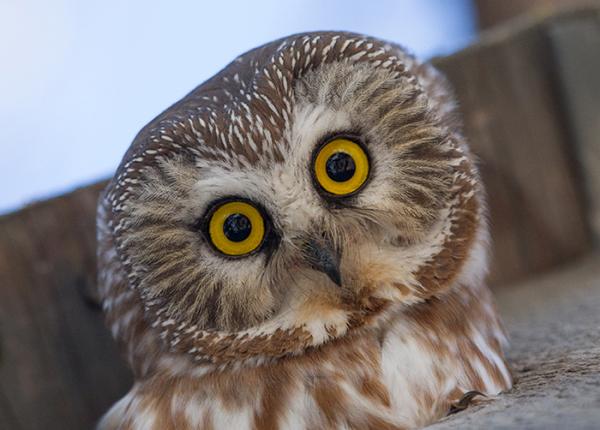Source: Into Birds
If you look closely at an owl’s eyes, you’ll notice the owl’s eye colors are different.
The color of an owl’s eyes tells a story about their lives.
An owl’s eye color helps us identify their species and indicates the time of day they predominantly hunt.
Although this isn’t always accurate with every owl species, as a birdwatcher, it helps pinpoint your best chances of seeing one.
Dark Brown or Black Owl’s Eyes
Owls with dark brown or black eyes are nocturnal, meaning they prefer to hunt at night.
The dark eye color doesn’t help the owls to see in the dark. It’s an evolutionary trait to help them to camouflage in the darkness.
There are many species of owls with dark eye colors, including the Northern Spotted Owl, Barred Owl, and Barn Owl.
You might have some of these owls in your back yard right now.
Barred Owls are large gray-brown and white birds with round heads, no ear tufts, brown eyes, and a small sharp dull yellow beak.This owl is named after the bars on its chest.
These owls can capture prey in total darkness with their incredible sense of hearing.
There’s a chance you might see one of these owls in daylight on a cloudy day, but these sightings are treasured moments.
Orange Owl’s Eyes
Owls with orange eyes are crepuscular, meaning they’re active during low light periods such as dusk and dawn.
Owls with orange eyes prefer hunting for their meal in the soft light of the early morning.
Species of owls with orange eyes include the Eurasian Eagle-owl. Eurasian Eagle-owls are visually striking animals with their bright orange eyes, mottled feathers, and ears tufts.
Yellow Owl’s Eyes
Owls with yellow eyes are diurnal and prefer to hunt during the daytime.
Great Gray Owls are patterned with fine white, gray, and brown streaking and faint barring. Their yellow eyes shine through the fine gray-and-brown concentric circles of their facial disk with two pale arcs forming an “X” between their eyes. Their habits are just like humans.
Owls with yellow eyes are active in the day and sleep at night.
Common owls with yellow eyes include Burrowing Owl, Great Gray Owl, Northern Saw-whet Owl, Short-earned Owl, Great Horned Owl and the Snowy Owl.
Their beauty is simply undeniable.
These owls have excellent eyesight but rely on their hearing to detect mice or other small rodents moving beneath the snow.
Then they swoop down and grab their prey with their talons.
The Short-eared owl has pale yellow to bright sulphur-yellow eyes with a greyish-brown cere, and a blackish bill. Their tiny ear-tufts are set close together near the center of its forehead, often not visible, and erected only when excited.
Luck is When Preparation Meets Opportunity
Success at finding an owl often results from being in the right place at the right time.
The Great Horned Owl is the quintessential owl of storybooks with its intimidating yellow-eyed stare The Great Horned Owl is the quintessential owl of storybooks with its intimidating yellow-eyed stare It takes patience, persistence, preparation, and some luck.
But the chance of seeing a beautiful up-close is worth the effort.
Now get out and see some owls.


You might have already done this, but a ‘talons’ post similar to this one on eyes would be very interesting. Thank you for this community!
There was a bit of talon talk with the Powerful Owl post and I think one about how talons keep sleeping baby owls from falling out of trees, but nothing comprehensive. I can do some research for that though.
I’ll check out the Powerful Owl, thanks!
No problem!
I’ve pulled a bunch of info on talons. I’m going to have to write up something good, so I’ll probably post it next weekend. I need to find lots of pictures and get everything in an order that makes sense. There are some really cool facts, but without visuals, it’s a bit tough to understand some of the anatomy that makes it all work.
Thank you for your time and efforts!
Of course! I like to learn and share what I learn with all of you.